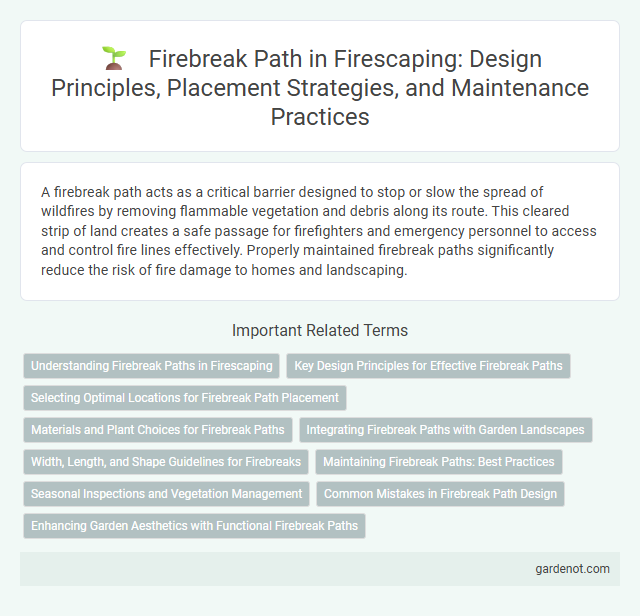A firebreak path acts as a critical barrier designed to stop or slow the spread of wildfires by removing flammable vegetation and debris along its route. This cleared strip of land creates a safe passage for firefighters and emergency personnel to access and control fire lines effectively. Properly maintained firebreak paths significantly reduce the risk of fire damage to homes and landscaping.
Understanding Firebreak Paths in Firescaping
Firebreak paths in firescaping serve as strategically cleared or maintained areas designed to slow or stop the spread of wildfires by removing combustible vegetation and debris. These paths create defensible spaces that reduce fuel continuity, enhancing protection for homes and properties adjacent to fire-prone landscapes. Proper placement and maintenance of firebreak paths are critical for maximizing their effectiveness in wildfire mitigation and landscape resilience.
Key Design Principles for Effective Firebreak Paths
Firebreak paths must be strategically positioned to interrupt fuel continuity, typically designed with a minimum width of 10 to 30 feet depending on vegetation type and slope to effectively slow or stop wildfire spread. Incorporating non-flammable materials such as gravel or bare soil in the path construction enhances fire resistance and reduces ember accumulation. Maintaining clear visibility and regularly removing debris ensures firebreak paths remain functional during critical fire events.
Selecting Optimal Locations for Firebreak Path Placement
Selecting optimal locations for firebreak path placement involves analyzing terrain features, vegetation density, and wind patterns to maximize fire containment effectiveness. Ideal firebreaks are positioned along natural barriers such as ridges or waterways, minimizing fuel availability and reducing fire spread potential. Incorporating access routes for firefighting equipment enhances response efficiency and safety during wildfire events.
Materials and Plant Choices for Firebreak Paths
Firebreak paths utilize non-flammable materials such as gravel, crushed stone, and concrete to effectively halt or slow wildfires. Plant selections for firebreaks typically include drought-tolerant, low-resin species like succulents, deciduous shrubs, and fire-resistant grasses that reduce combustible fuel loads. Incorporating native, fire-adapted vegetation alongside hardscape elements optimizes firebreak effectiveness while maintaining ecological balance.
Integrating Firebreak Paths with Garden Landscapes
Firebreak paths serve as vital barriers that slow the spread of wildfires by removing combustible materials and creating defensible zones around garden landscapes. Integrating firebreak paths strategically within garden designs enhances both safety and aesthetics, using gravel, stone, or other non-flammable materials that complement plant choices and garden features. Effective placement ensures clear access for emergency responders while maintaining the natural flow and visual appeal of the landscape.
Width, Length, and Shape Guidelines for Firebreaks
Firebreak paths should maintain a minimum width of 10 to 15 feet to effectively prevent fire spread by removing combustible vegetation. The length of firebreaks varies depending on property size but must extend continuously around vulnerable areas to create effective containment zones. Optimal firebreak shapes include straight or gently curving lines that minimize sharp angles to reduce wind turbulence and improve firefighter accessibility.
Maintaining Firebreak Paths: Best Practices
Maintaining firebreak paths involves regularly clearing vegetation, debris, and flammable materials to prevent wildfire spread and ensure unobstructed access for firefighting efforts. Consistent inspection and upkeep of firebreak widths, removal of invasive species, and proper grading improve their effectiveness as barriers. Employing mulch or gravel on firebreak surfaces can reduce erosion and retard fuel accumulation, enhancing long-term fire resilience.
Seasonal Inspections and Vegetation Management
Firebreak paths require regular seasonal inspections to ensure they remain clear of flammable debris and overgrown vegetation that could facilitate wildfire spread. Effective vegetation management involves removing dead plants, trimming shrubs, and maintaining low fuel loads along these paths to create defensible space. Consistent monitoring during dry seasons helps maintain firebreak integrity and enhances wildfire prevention efforts.
Common Mistakes in Firebreak Path Design
Firebreak paths often suffer from being too narrow, reducing their effectiveness in halting wildfire spread. Improper maintenance leads to vegetation encroachment, which can easily reignite fires across the break. Failure to consider prevailing wind directions and topography in the design compromises the firebreak's ability to function as a reliable barrier during critical fire events.
Enhancing Garden Aesthetics with Functional Firebreak Paths
Firebreak paths serve as strategic design elements that enhance garden aesthetics while providing essential fire protection by preventing wildfire spread. Integrating drought-resistant plants and decorative gravel along these firebreaks not only boosts visual appeal but also maintains soil stability and reduces flammable material. Properly designed firebreak paths create safe, accessible walkways that blend functionality with landscape beauty, contributing to a harmonious garden environment.
Firebreak path Infographic

 gardenot.com
gardenot.com